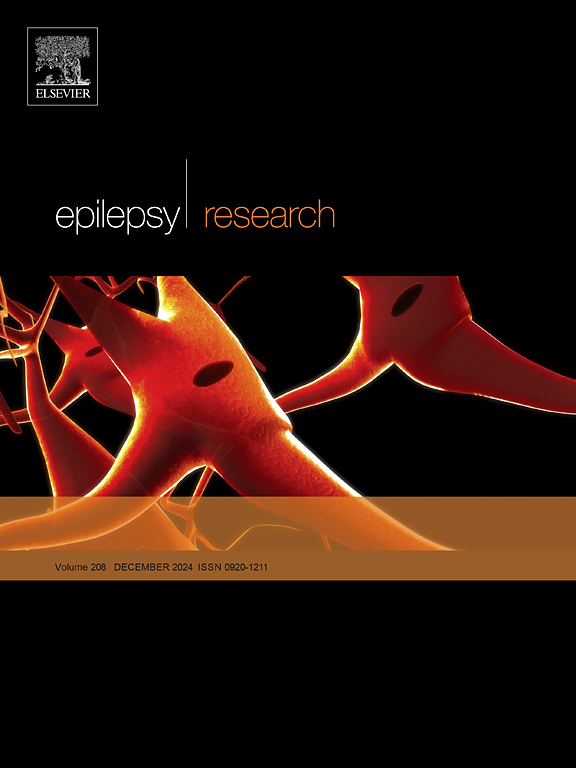Investigation of in-vivo GABA+ and Glutamate levels in patients with drug resistant unilateral temporal lobe epilepsy using MEGA-PRESS and correlates with clinical semiology
IF 2
4区 医学
Q3 CLINICAL NEUROLOGY
引用次数: 0
Abstract
Background
In this study, we used in vivo MEGA-PRESS spectroscopy to investigate GABA and Glu levels in patients with drug-resistant unilateral temporal lobe epilepsy (TLE) and also look for correlation between neurometabolites and clinical semiology assessed by other modalities.
Materials and methods
Twenty-five patients with TLE underwent MRS data acquisition on a 3.0 T MRI. Bilateral single-voxel MEGA-PRESS data was acquired from mesial temporal lobes, and data was post-processed using MRSpa and LC-Model for computing neurometabolites concentration. Tissue segmentation from spectroscopic voxel was performed for tissue metabolite and CSF correction. Statistical analysis was performed to analyze differences in neurometabolic between affected and normal-sides and clinical correlations.
Results
GABA, Glu, NAA, Cr, and Cho neurometabolites were computed. The group-wise statistical comparison revealed a significantly reduced NAA level from the affected compared to normal-side of the hippocampus (p-value=0.039). We observed reduced GABA (p-value=0.07) values and hippocampal volume (p-value<0.001) were observed from the affected side. A significant negative correlation was noted between affected-side hippocampal volume and NAA concentration (rho=-0.497, p-value=0.05). Glu/NAA ratios from both affected (rho=-0.692, p-value=0.012) and normal-sides (rho=-0.608, p-value=0.016) of the hippocampus were negatively correlated with age. Concordance between neurometabolites with video-EEG for lateralization demonstrates correct classification percentage for GABA was 86.7 %, indicating that there is an 86.7 % chance that GABA will be able to lateralize the unaffected side as detected by VEEG.
Conclusion
A novel exploratory study demonstrates an alternation of in-vivo GABA and Glu levels and hippocampal volume. This study may provide a direction for utilizing MEGA-PRES as a presurgical tool for assessing in-vivo neurometabolic profiles and add to the knowledge of the role of GABA and Glu in epilepsy and its interplay.
应用MEGA-PRESS研究耐药单侧颞叶癫痫患者体内GABA+和谷氨酸水平及其与临床符号学的相关性
在这项研究中,我们使用体内MEGA-PRESS光谱研究耐药单侧颞叶癫痫(TLE)患者的GABA和Glu水平,并寻找神经代谢物与其他方式评估的临床符会学之间的相关性。材料与方法25例TLE患者在3.0 T MRI上进行MRS数据采集。从内侧颞叶获取双侧单体素MEGA-PRESS数据,并使用MRSpa和LC-Model对数据进行后处理,计算神经代谢物浓度。从光谱体素中进行组织分割,用于组织代谢物和CSF校正。统计学分析患侧与正常侧神经代谢差异及临床相关性。结果计算gaba、Glu、NAA、Cr、Cho神经代谢物。组间统计比较显示,与正常侧海马相比,受损侧海马的NAA水平显著降低(p值=0.039)。我们观察到患侧GABA减少(p值=0.07),海马体积减少(p值<;0.001)。患侧海马体积与NAA浓度呈显著负相关(rho=-0.497, p值=0.05)。海马受累侧(rho=-0.692, p值=0.012)和正常侧(rho=-0.608, p值=0.016)的Glu/NAA比值与年龄呈负相关。神经代谢物与视频脑电图侧化的一致性表明,GABA的正确分类率为86.7 %,表明VEEG检测到的GABA能够侧化未受影响的一侧的几率为86.7 %。结论一项新的探索性研究证实了体内GABA和Glu水平与海马体积的变化。本研究可能为利用MEGA-PRES作为术前评估体内神经代谢谱的工具提供方向,并增加对GABA和Glu在癫痫中的作用及其相互作用的认识。
本文章由计算机程序翻译,如有差异,请以英文原文为准。
求助全文
约1分钟内获得全文
求助全文
来源期刊

Epilepsy Research
医学-临床神经学
CiteScore
0.10
自引率
4.50%
发文量
143
审稿时长
62 days
期刊介绍:
Epilepsy Research provides for publication of high quality articles in both basic and clinical epilepsy research, with a special emphasis on translational research that ultimately relates to epilepsy as a human condition. The journal is intended to provide a forum for reporting the best and most rigorous epilepsy research from all disciplines ranging from biophysics and molecular biology to epidemiological and psychosocial research. As such the journal will publish original papers relevant to epilepsy from any scientific discipline and also studies of a multidisciplinary nature. Clinical and experimental research papers adopting fresh conceptual approaches to the study of epilepsy and its treatment are encouraged. The overriding criteria for publication are novelty, significant clinical or experimental relevance, and interest to a multidisciplinary audience in the broad arena of epilepsy. Review articles focused on any topic of epilepsy research will also be considered, but only if they present an exceptionally clear synthesis of current knowledge and future directions of a research area, based on a critical assessment of the available data or on hypotheses that are likely to stimulate more critical thinking and further advances in an area of epilepsy research.
 求助内容:
求助内容: 应助结果提醒方式:
应助结果提醒方式:


